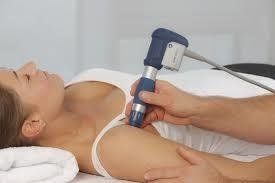SHOCKWAVE THERAPY
Shockwave Therapy

Shockwave therapy, introduced in medicine over 20 years ago to break up kidney stones without causing skin damage, is now commonly used in orthopaedics, physiotherapy, sports medicine, and aesthetic medicine.
The radial pressure waves generated by the device trigger a cascade of positive biological effects that lead to rapid and lasting tissue regeneration. This results in quick pain relief and the restoration of joint mobility. Several theories exist regarding the physical effects of radial pressure waves:
Pain Reduction: According to the “Gate Control” theory, the intense pulses emitted from the transmitter to the tissue inhibit the transmission of pain signals along the nerve fibres.
Increased Metabolism: Shockwaves affect tissue at the cellular level, altering the chemical environment of the cells with free radicals, promoting the release of substances that inhibit pain and inflammation.
Revascularisation: Repeated application of shockwaves to injured skin areas promotes revascularisation, with new blood flow enhancing healing and rapid tissue regeneration.
Reduced Muscle Tone: The "vicious cycle" caused by the strong association between pain and muscle tone is broken, so with pain reduction, normal muscle tone is restored.
Clinical studies, conducted in accordance with evidence-based medicine principles, have demonstrated the effectiveness of shockwave therapy in treating long-term disorders of tendinous insertions and soft tissues:
- TENNIS ELBOW: lateral epicondylitis
- SUB-ACROMIAL IMPINGEMENT SYNDROME: painful shoulder
- GREATER TROCHANTERIC PAIN SYNDROME
- PATELLAR TENDINOPATHY
- MEDIAL TIBIAL STRESS SYNDROME: shin splints
- INSERTIONAL TENDINOPATHY & MEDIAL ACHILLES TENDON PAIN
- PLANTAR FASCIITIS & HEEL SPUR
- CALCIFIC SHOULDER TENDINITIS
Other indications:
- DIFFICULT SKIN LESIONS
- CELLULITE TREATMENT
- BODY CONTOURING
- LYMPHATIC DRAINAGE
Clinical studies are ongoing for the treatment of Osgood-Schlatter syndrome, idiopathic low back pain, pseudo-radicular syndrome, and myofascial pain syndrome, with results to be published soon.
Our operators:
Dell'Aira Ruben
Liporato Marco
CORTE DELLA SALUTE MULTI-SPECIALTY MEDICAL CENTRE
61, Via Magenta - 20021 Bollate (MI) - Italy | VAT No. 06704480968 | Tel. +39 02 3501312 | Fax. +39 02 92869916 |




